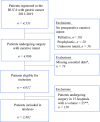Failure to Cure in Patients Undergoing Surgery for Gastric Cancer: A Nationwide Cohort Study
- PMID: 33486644
- PMCID: PMC8253712
- DOI: 10.1245/s10434-020-09510-6
Failure to Cure in Patients Undergoing Surgery for Gastric Cancer: A Nationwide Cohort Study
Abstract
Background: This study aimed to describe the incidence of failure to cure (a composite outcome measure defined as surgery not meeting its initial aim), and the impact of hospital variation in the administration of neoadjuvant therapy on this outcome measure.
Methods: All patients in the Dutch Upper Gastrointestinal Cancer Audit undergoing curatively intended gastric cancer surgery in 2011-2019 were included. Failure to cure was defined as (1) 'open-close' surgery; (2) irradical surgery (R1/R2); or (3) 30-day/in-hospital mortality. Case-mix-corrected funnel plots, based on multivariable logistic regression analyses, investigated hospital variation. The impact of a hospital's tendency to administer neoadjuvant chemotherapy on the heterogeneity in failure to cure between hospitals was assessed based on median odds ratios and multilevel logistic regression analyses.
Results: Some 3862 patients from 28 hospitals were included. Failure to cure was noted in 22.3% (hospital variation: 14.5-34.8%). After case-mix correction, two hospitals had significantly higher-than-expected failure to cure rates, and one hospital had a lower-than-expected rate. The failure to cure rate was significantly higher in hospitals with a low tendency to administer neoadjuvant chemotherapy. Approximately 29% of hospital variation in failure to cure could be attributed to different hospital policies regarding neoadjuvant therapy.
Conclusions: Failure to cure has an incidence of 22% in patients undergoing gastric cancer surgery. Higher failure to cure rates were seen in centers administering less neoadjuvant chemotherapy, which confirms the Dutch guideline recommendation on the administration of neoadjuvant chemotherapy. Failure to cure provides short loop feedback and can be used as a quality indicator in surgical audits.
Conflict of interest statement
Mark I. van Berge Henegouwen is a consultant for Mylan, Johnson & Johnson, and Medtronic, and received research grants from Olympus and Stryker. Richard van Hillegersberg is proctoring surgeon for Intuitive Surgical Inc. and trains other surgeons in robot-assisted minimally invasive esophagectomy. Daan M. Voeten, Leonie R. van der Werf, Janneke A. Wilschut, Linde A.D. Busweiler, and Johanna W. van Sandick have declared no conflicts of interest.
Figures



References
-
- Cats A, Jansen EPM, van Grieken NCT, et al. Chemotherapy versus chemoradiotherapy after surgery and preoperative chemotherapy for resectable gastric cancer (CRITICS): an international, open-label, randomised phase 3 trial. Lancet Oncol. 2018;19(5):616–628. doi: 10.1016/S1470-2045(18)30132-3. - DOI - PubMed
MeSH terms
LinkOut - more resources
Full Text Sources
Other Literature Sources
Medical

